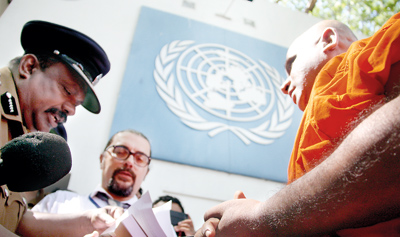News
Navi Pillay confronted with ‘missing’ stories, demos on 7-day visit
- Hardline groups oppose her presence, others want spotlight on LTTE atrocities
- Journalists say self-censorship practised due to fear
- Ms. Pillay sees reconstruction taking place, impressed by warmth, hospitality of Lankans
Sri Lanka first invited the United Nations High Commissioner for Human Rights to visit in April 2011. When Navi Pillay finally undertook her overdue excursion, it coincided with the week in which the UN observes International Day of the Victims of Enforcd Disappearances.

A protest by the Sihala Ravaya in front of the UN office in Colombo yesterday. Pix by Indika Handuwala
At seven days, this was also the longest official visit to a single country that Ms. Pillay has made since taking over as UN human rights chief in September 2008. She arrived on Monday and left yesterday. Everywhere the High Commissioner went in Sri Lanka, she was confronted with the subject of disappearances—both of Tamils and of Sinhalese. Not only did she hear impassioned pleas from the families of missing people in the North and East, they demonstrated on the streets and followed her to Colombo with laminated photographs of loved ones.
On August 30, the International Day of the Victims of Enforced Disappearances, Ms. Pillay attended two closed-door meetings with relatives of the disappeared in Colombo. The gathering at the Sri Lanka Foundation Institute (SLFI) comprised predominantly of Tamil people who had travelled from all parts of the North and East, including Jaffna, Mannar, Batticaloa and Mullaitivu. There were also a few persons from the South and members of the Catholic clergy.
After the discussion, at which nine representatives had made speeches, the families marched in procession to Independence Square. The majority of them were women, some carrying polythene bags with birth certificates or other documents. A few young children tagged along. They held candles, inserted into disposable drinking cups to protect the flames from the breeze, and sang a trilingual song. Many wept.
From the SLFI, Ms. Pillay was escorted to the Bandaranaike Memorial International Conference Hall (BMICH) where representations were made by members, a majority of them Sinhala, of the Collective of Parents of the Dead and Missing. These were relatives of military personnel who had perished in the war, at the hands of the LTTE or were missing. There was no vigil following this event.
Near many of the venues that the High Commissioner frequented, there were demonstrations. This caused the police to take extraordinary measures to assure security. Personnel were deployed in force, with senior police officers also being seen on site at all locations.
Yesterday morning, journalists were constrained to present themselves at the UN headquarters in Bauddhaloka Mawatha between 9 a.m. and 9.30 a.m. for a briefing scheduled to start at 11 a.m. The early start was “due to security concerns”, the UN office said.
Some groups, such as the Ravana Balaya, opposed the delegation’s visit outright. Led by Buddhist monks, the organisation assembled large numbers at Bauddhaloka Mawatha demanding that the UN stop interference in Sri Lanka’s affairs. Other groups urged Ms. Pillay to shed bias in how she viewed the conflict and to focus attention on atrocities committed by the LTTE.
Many more pleaded with her to help locate their missing relatives. In Jaffna, there were two such demonstrations. Among the recognisable faces in the crowd were Sandya Ekneligoda, wife of missing journalist Prageeth Ekneligoda, and Ananthi Sasitharan, wife of Velayutham Sasitharan alias Elilan, the LTTE’s Trincomalee leader. Mrs. Sasitharan was quoted as saying she believes her husband is still alive and in detention.
Ms. Pillay also held a closed-door meeting with some Tamil activitsts and civil society members at the UN office in Jaffna. Later, the UN delegation visited Mullivaikkal in the Mullaitivu district, where some of the worst battles had taken place at the end of the war in 2009.
Newswires said that Tamil families had complained to her about “missing relatives, military land grabs and life without basic facilities”. They also cited her as saying she would raise their complaints with the Government.
Ms. Pillay held extensive deliberations with Government officials in towns and cities. Her programme was tightly scheduled in order to make maximum use of time. Often, she rushed from meeting to meeting. At the news conference, she apologised for not having had sufficient time for everyone who had requested appointments with her.
For instance, her agenda on Friday afternoon included discussions with Opposition Leader Ranil Wickremesinghe, Economic Development Minister Basil Rajapaksa and President Mahinda Rajapaksa—all within a short space of time. That morning, she also met the Tamil National Alliance and Defence Secretary Gotabaya Rajapaksa.
The President’s office quoted Ms. Pillay as saying she would now be able to report “on the very many achievements that have been made”. For instance, it had been visible to her how much has been invested in reconstruction.
Most meetings were approved and closely overseen by the Government. Media said however, that the delegation had made some unforeseen changes to its schedule in Trincomalee. Two meetings were conducted in secret with civil society activists, including a Jesuit priest.
Questioned about this at the news conference, Ms. Pillay said there had been no alterations to her schedule. “I know there was some media speculation about a new meeting,” she remarked. “I with the help of my advisors ensured that the meetings with some people were conducted in confidence. We can’t invite the public to every meeting and that’s probably what gave rise to the speculation.”
On Thursday afternoon, representatives of the journalist groups apprised members of Ms. Pillay’s delegation about their concerns pertaining to freedom of expression. An alliance of media organisations handed over a memorandum, highlighting their main issues.
The document decried that many Sri Lankan journalists were self-censoring due to fear. “Journalists have been approached by Government supporters with offers of money, jobs and guarantees of safety if they were ready to toe the Government line,” it observed. “Reporters often complain that Editors will delete references critical of the Government. Even family members of journalists appeal to them to refrain from writing and broadcasting anything critical of the Government due to fears about safety.”
Significantly, Ms. Pillay also addressed the Youth Parliament. At the news conference, she said she hoped that, when its members graduated to the main political stage, they would “usher in a new era of tolerant coexistence in this beautiful island…”
Ms. Pillay will now give an oral update to the Human Rights Council in Geneva in late September and a full written report in March 2014. She told journalists that her most compelling memory of her visit to Sri Lanka was “the warmth and hospitality of Sri Lankans.”
“It’s really very moving,” she said, smiling. “And when they approached me, it wasn’t a particular language, group or religion. It was Sri Lankans. I’m quite overwhelmed when they said this visit is very important for them. So to them I told them that we will keep the lens on Sri Lanka and help Sri Lanka in any way we can.“

